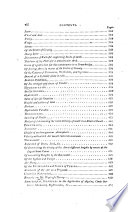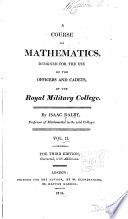 | Isaac Dalby - Mathematics - 1806 - 526 pages
...is a retarding force in machines, arising from the parts rubbing against one another. 311. AXIOMS. I. Every body perseveres in its state of rest, or uniform motion in a right line, unless it be compelled to change that state by some external force. 3. The alteration or... | |
 | Isaac Dalby - Mathematics - 1813 - 538 pages
...a retarding force in machines, arising from the paits rubbing against one another. 314. AXIOMS. 1. Every body perseveres in its state of rest, or uniform motion in a right line, unless it be compelled to change that state by some external force. 2. The alteration or... | |
 | James Mitchell - Mathematics - 1823 - 666 pages
...latter, centrifugal. The doctrine of central forces depends on the first Newtonian Jaw of motion ; viz. " Every body perseveres in its state of rest, or uniform motion in a right line, until a change is effected in it by the agency of some external force." M. de Moivre, in... | |
 | Literature - 1907 - 848 pages
...electricity exhibits a quality akin to the "inertia" of matter, which tends to retain every material body in its) state of rest or uniform motion in a straight line except so far as it is compelled by forces to change that state. This at once raises for us the new... | |
 | William Pinnock - 1847 - 134 pages
...on which he has supported the whole system of his philosophy, are the three following : 14. First, Every body perseveres in its state of rest or uniform motion in a right line, until a change is effected by the agency of some external force. 15. Second, Any change... | |
 | John Craig (F.G.S.) - 1849 - 1148 pages
...will bo four horses. The laws of motion are as follows, as delivered by Sir I. Newton : — First, every body perseveres in its state of rest, or uniform motion in a ri¿ht line, until a chango ¡s effected by the agency of some external force. Second, any chango effected... | |
 | William Makepeace Thackeray - Electronic journals - 1907 - 872 pages
...electricity exhibits a quality akin to the ' inertia ' of matter, which tends to retain every material body in its state of rest or uniform motion in a straight line except so far as it is compelled by forces to change that state. This at once raises for ns the new... | |
 | Aubrey William O. Saunders - 1861 - 162 pages
...exhausted, in the line of fire, agreeably to the first law of motion, by which every tody must persevere in its state of rest or uniform motion in a straight line, unless it be compelled to change that state by forces impressed upon it. Why cannot the bullet do this ? Because... | |
 | P. Austin Nuttall - Science - 1869 - 356 pages
...changing position in space. — The la,ws of motion are tbus illustrated by Sir Isaac Newton : — ist, every body perseveres in its state of rest or uniform motion in a right line, until a change is ted by the agency of some nal force ; and, any change effected in the... | |
 | James Clerk Maxwell - 1878 - 252 pages
...two aspects of the action between two bodies, as it affects the one body or the other. THE FIRST LAW OF MOTION. — Law I. Every body perseveres in its state of rest or of moving uniformly in a straight line, except in so far as it is made to change that state by external... | |
| |